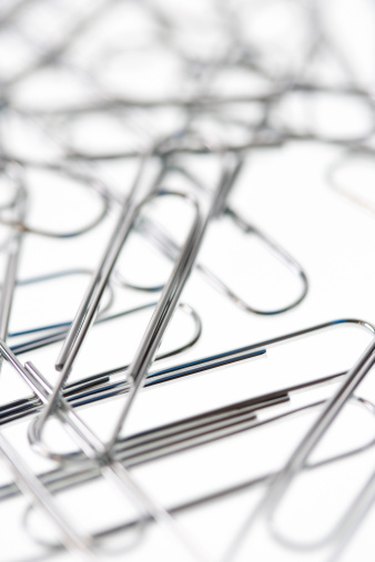Things You'll Need
Sewing machine for home use
Vinyl or foam
Paperclips
Waxed paper, cut in 12-inch-long pieces
Talcum powder
Variety of sewing needles
Thread
Scissors

Vinyl and foam are practical and versatile materials in projects, especially for the home and costumes. Both can be problematic to sew. Vinyl can be stiff and heavy, tear easily, and be slippery and hard to handle. Foam can break needles on the sewing machine and is difficult to hold steady for a straight line. Fortunately, there are simple and inexpensive solutions to these problems that will not require purchasing an expensive industrial sewing machine.
Step 1
Instead of needles, secure the hem or the pieces you want to sew together with paperclips. For foam, paperclips can also work better and more safely than pins.
Video of the Day
Step 2
For sewing vinyl, put waxed paper on the top of the material to sew, and sew slowly. If waxed paper is not available, talcum powder also can keep the vinyl from sliding around while sewing.
Step 3
For sewing foam, put waxed paper on the top and bottom of what you are sewing, and sew slowly. The bottom piece of waxed paper prevents the machine's feed dogs from catching on the foam. It may be necessary to raise the pressure foot so the foam can be easily fed through the machine.
Step 4
For foam that is more than a 1/2-inch thick, cut out cardboard from a cereal box and use it to press the foam down on either side of the stitching.
Step 5
Take the material off the sewing machine and gently tear off the wax paper from the seam. If using talcum powder with vinyl, wipe it off with a damp cloth.
Tip
Work with vinyl at room temperature because then it is more pliable and less likely to tear. Use good quality waxed paper. It may be necessary to use a different needle size for both vinyl and foam.
Warning
Sewing mistakes in vinyl are visible because the needle holes will remain. If a mistake does happen, try using a warm blow dryer and rubbing a little with your finger to close them up. Be careful with the heat or the vinyl will burn or ripple. If you are making a hem in vinyl, fold it only once because vinyl will not fray. Plus, the extra fold makes extra bulk that is noticeable in the finished product.
Video of the Day